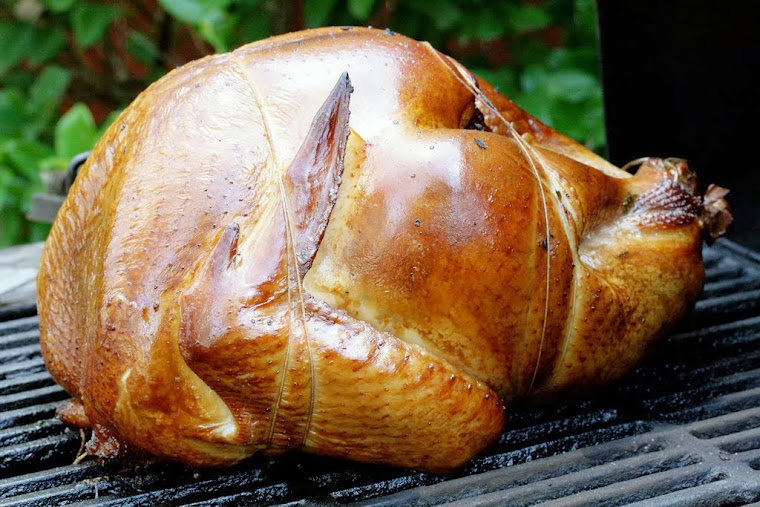Check this out. Really, go check it out. Laser-cut nori into an intricate shape. Now *that's* a garnish.
So how long before we have a KitchenAid consumer-rated computer-guided 30 W laser cutter?
More at the newest addition to my blogroll: Seattle Food Geek (via eGullet).
27 April 2010
22 April 2010
Lamb kebabs
Went camping this weekend - Joshua Tree. What a fabulous place! Trees that look like they're from another planet. Rockscape to match. And everything in bloom. Wow.

We wanted to live large, and eat well while camping. I mean, what's better than a day of hiking followed by a delicious dinner? But it has to be easy to make in a camp site with minimal implements, and has to be delicious. First night, we had bratwurst. I parboiled the brats at home, and then packed them in the cooler and finished them on the grill at the campsite. Simple.
Second night, lamb kebabs, modified from Serious Barbecue (where else?). Now this is living large. Sweaty. Exhausted. And eating lamb-on-a-stick. Isn't everything better on a stick?
(where else?). Now this is living large. Sweaty. Exhausted. And eating lamb-on-a-stick. Isn't everything better on a stick?
I made the marinade at home:
Finally, the glaze. Mix:
An hour before dinner, soak the skewers in water in the last ziploc bag. You want to keep them from catching fire. Remove the lamb from the cooler to warm up.

Fire up the grill. When it gets up to temperature, take the skewers out of the water, and run them through the meat, with a small amount of space between each chunk.
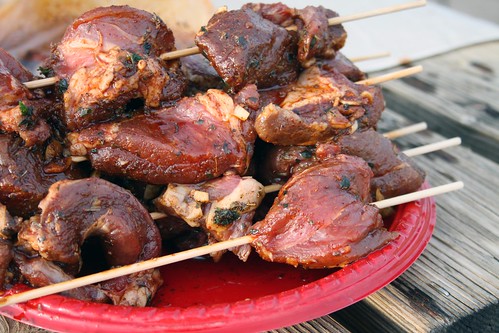
Toss them on the grill. Three minutes per side, then brush with the glaze.

About five additional minutes for medium rare, to eight minutes for medium well. Brush with glaze frequently.
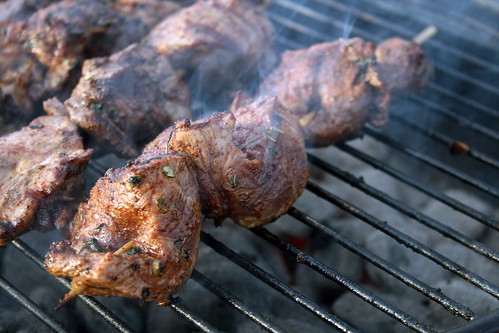
Look at that!!!
This tasted amazing. Granted, hunger is the best sauce (or hiking exhaustion), but this was delicious.
We served with grilled kebabs of red, orange and yellow bell peppers, and pita bread. (Be careful with this recipe, we had someone from a neighboring campsite come visit because of what he smelled and saw. He asked what we were grilling, and asked "Is that gourmet?" You'll have to send strangers away lambless if you don't bring enough for everyone...)

We wanted to live large, and eat well while camping. I mean, what's better than a day of hiking followed by a delicious dinner? But it has to be easy to make in a camp site with minimal implements, and has to be delicious. First night, we had bratwurst. I parboiled the brats at home, and then packed them in the cooler and finished them on the grill at the campsite. Simple.
Second night, lamb kebabs, modified from Serious Barbecue
I made the marinade at home:
1 cup extra virgin olive oilMix together in a ziploc bag, and put the bag in the cooler with ice. Meanwhile, chop:
10 garlic cloves, peeled and chopped
1 tbsp marjoram
3 tbsp fresh thyme
1 tbsp oregano
1 tbsp ancho powder
1 tsp kosher salt
1 tbsp coarsely ground black pepper
½ tsp MSG
2 tsp cayenne
3 pounds boneless leg of lambinto 1.5 inch cubes. Plus or minus. Toss them in a second ziploc bag, and suck all the air out. Toss this bag into the cooler, too. (I did this two days before serving).
Finally, the glaze. Mix:
½ cup fresh squeezed lemon juicePour into a jar, keep cold in the cooler. Now you're ready for camping, bring a grill, some skewers and 1 more ziploc bag. Go camp, hike, enjoy. 4-12 hours before cooking, pour the chopped lamb into the bag with the marinade. Let marinate in the cooler until an hour before dinner.
¼ cup water
¼ sugar
1 tbsp coarsely chopped thyme
1 tbsp marjoram
1 tbsp serrano peppers, chopped
1 tbsp fresh rosemary, chopped
An hour before dinner, soak the skewers in water in the last ziploc bag. You want to keep them from catching fire. Remove the lamb from the cooler to warm up.

Fire up the grill. When it gets up to temperature, take the skewers out of the water, and run them through the meat, with a small amount of space between each chunk.

Toss them on the grill. Three minutes per side, then brush with the glaze.

About five additional minutes for medium rare, to eight minutes for medium well. Brush with glaze frequently.

Look at that!!!
This tasted amazing. Granted, hunger is the best sauce (or hiking exhaustion), but this was delicious.
We served with grilled kebabs of red, orange and yellow bell peppers, and pita bread. (Be careful with this recipe, we had someone from a neighboring campsite come visit because of what he smelled and saw. He asked what we were grilling, and asked "Is that gourmet?" You'll have to send strangers away lambless if you don't bring enough for everyone...)
Keywords:
direct heat,
main course
19 April 2010
Everyone who eats meat should see this.

No, this isn't some alarming PeTA video. This is the tale of "honestly raised honorably killed pork". Go read more at Hounds in the Kitchen. Fantastic:
What follows is a factual account of how we humanely harvested this meat animal. It was hard manual labor that we attended to with reverence for the life we took.
I have included pictures to illustrate exactly what happened. Some readers may find this subject and the photographs graphic. If that’s the case for you, you might want to wait to read a reflective and less intense post I will publish next week. Intrepid readers, keep on.
Keywords:
meat
15 April 2010
Knives
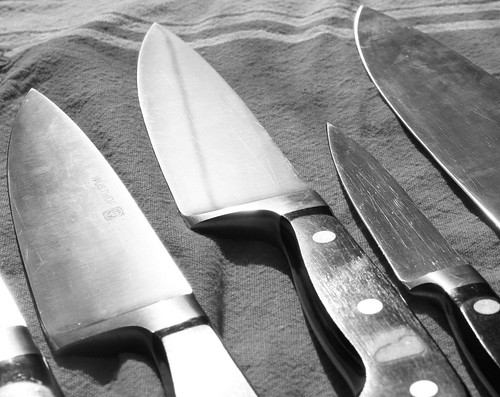
Sharp knives are a dream to work with. They make routine tasks enjoyable. It's also important to have sharp knives in the kitchen, because they're less likely to slip on the material you're cutting, and you're less likely to hurt yourself. When I'm planning on cooking at someone's house, I will bring my own knives because it's that much more fun.
But you have to treat your knives well (for an excellent knife primer, go here). Cut on a cutting board. Don't put them in the dishwasher (rattling around in there, they'll get dull in no time). Store them somewhere they won't bang into your other kitchen toys. And get them sharpened.
I've recently discovered a new small knife sharpener here in San Diego. They did a great job on my knives in 20 minutes, and they'll come to you for an extra fee. They're inexpensive (they did my 4 chef's knives, plus a paring knife, carving knife and kitchen shears for $20). And my knives are now so sharp, I can cut through the fabric of reality. That's right. They're *that* sharp.
My only complaint? Their hours are pretty consumer-unfriendly, they're only open a few hours, during normal business hours, only on weekdays. (Do they do most of their business with restaurants?)
True Sharp.
View Larger Map
Note added Dec 22, 2010: On my second visit to True Sharp, they did another excellent job. In discussions with me, they clarified two things: One, they do not have the facilities to properly sharpen Japanese knives. Not surprising, after all, Japanese knives are a pretty niche item. Second, most of their business is restaurants. But they have recently modified their shop hours to be more consumer-friendly. Mon - Wed: 11am - 7pm. Thanks, guys. They do excellent work. And now my knives are ready for some good holiday cookin'.
Keywords:
vendor review
13 April 2010
Steak
A busy weekend. Children's birthday parties. Time in the lab. At the gym. At the beach. But we've decided that we want a regular Sunday night family dinner. What's something fantastic? Fast? Delicious? Oh yeah, baby. How about a sirloin steak. Quick stop at the grocery store to pick up steaks, and while Mrs. Dude puts Bbq Jr. down for a nap, I start marinating the steak (modified from one of my favourite books ever Serious Barbecue ):
):

Half an hour before grill time, remove the marinating steak from the fridge and allow them to come to room temperature (so they're not warming on the grill, they're cooking). Fire up the grill. Get it screaming hot.
Cooking steak always makes me nervous. Unlike brisket, where the difference between properly cooked and overcooked is roughly 3 hours, with steak, you have seconds between properly cooked and overcooked. STRESS!!! No. No. No stress. Steak, is just something where you need a bit of practice.
Okay, so while the grill is heating up, make the resting butter:
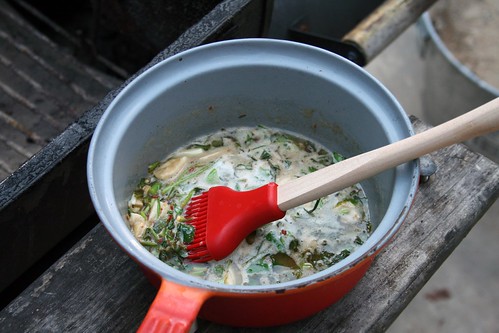
Put the steaks on the grill. Three minutes per side for rare. 6 minutes per side for medium well.
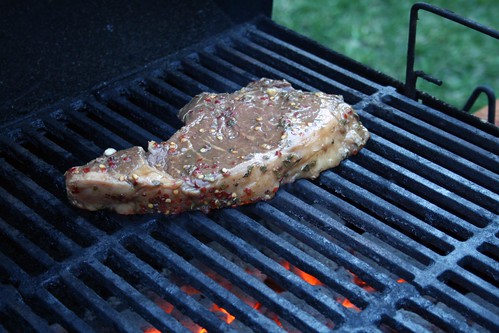
Dial in the proper length of time for your temperature grill and thickness of steak. Don't be stressed. This just requires practice, nothing more, nothing less. Practice your steaks.
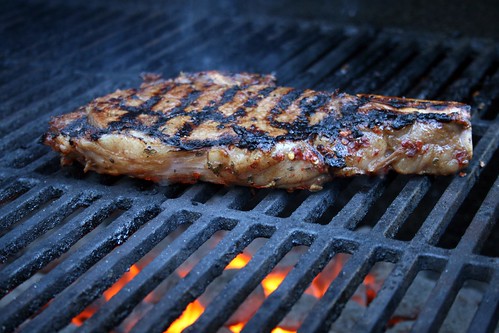
When done to your liking, remove the steak from the grill, and allow it to rest. Resting is this weird thing, most people who write about getting meat to rest talk about the "juices redistributing". It's a well known effect that if you cut the meat right after you cook it, the juices will come streaming out, and you'll have drier meat. If you wait a bit, the juices stay in the meat. The juice redistributing story sounds like just so much bulls*@t if you ask me. More likely is that the fat in the meat is congealing, and holding some of the liquid in that way. Either way, letting the meat rest results in juicier meat.
While the meat rests, brush on the resting butter.
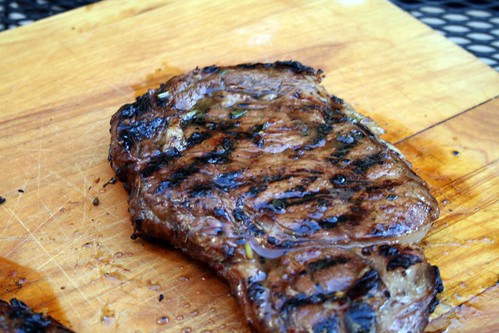
Sprinkle with:

Interesting thing about this steak preparation? The fat bits of steak are particularly delicious. I mean, the rest of it is steak, so unless you overcook it, of course it's delicious. But the fatty bits? Yum.
Serve with an assertive red. Cabernet sauvignon, red zinfandel or mourvèdre.

1 tbsp crushed hot red pepper flakesSoak the red pepper flakes in the boiling water for a few minutes. Combine all ingredients, pour into a ziploc bag with 2 sirloin steaks. Marinate 1 - 4 hours.
2 tbsp boiling water
½ cup Worcestershire sauce
¼ cup Dijon mustard
2 tbsp honey
1 tbsp soy sauce
½ cup coarsely chopped white onion
10 garlic cloves, chopped
1 tsp dried oregano

Half an hour before grill time, remove the marinating steak from the fridge and allow them to come to room temperature (so they're not warming on the grill, they're cooking). Fire up the grill. Get it screaming hot.
Cooking steak always makes me nervous. Unlike brisket, where the difference between properly cooked and overcooked is roughly 3 hours, with steak, you have seconds between properly cooked and overcooked. STRESS!!! No. No. No stress. Steak, is just something where you need a bit of practice.
Okay, so while the grill is heating up, make the resting butter:
4 tbsp unsalted butterMelt the butter, and mix the rest of the ingredients in.
¼ cup finely chopped flat-leaf parsley
1 tbsp freshly squeezed lime juice
1 tbsp Worcestershire sauce
4 garlic cloves, shopped
1 tsp crushed hot red pepper flakes
1 tbsp chopped fresh rosemary
1 tbsp chopped fresh thyme

Put the steaks on the grill. Three minutes per side for rare. 6 minutes per side for medium well.

Dial in the proper length of time for your temperature grill and thickness of steak. Don't be stressed. This just requires practice, nothing more, nothing less. Practice your steaks.

When done to your liking, remove the steak from the grill, and allow it to rest. Resting is this weird thing, most people who write about getting meat to rest talk about the "juices redistributing". It's a well known effect that if you cut the meat right after you cook it, the juices will come streaming out, and you'll have drier meat. If you wait a bit, the juices stay in the meat. The juice redistributing story sounds like just so much bulls*@t if you ask me. More likely is that the fat in the meat is congealing, and holding some of the liquid in that way. Either way, letting the meat rest results in juicier meat.
While the meat rests, brush on the resting butter.

Sprinkle with:
fleur de selServe. Shown medium well (just the way Mrs. Dude likes it - I'm more a rare/medium-rare guy).

Interesting thing about this steak preparation? The fat bits of steak are particularly delicious. I mean, the rest of it is steak, so unless you overcook it, of course it's delicious. But the fatty bits? Yum.
Serve with an assertive red. Cabernet sauvignon, red zinfandel or mourvèdre.

Keywords:
direct heat,
main course
10 April 2010
Food Geek
Complex sugars can be difficult for humans to digest. Indeed, many of the complex sugars that we "digest" actually aren't digested by us, they are digested by the plethora of bacteria that live in our guts. We provide a warm home for them, and a steady supply of food. They provide metabolic capabilities that we don't possess.
A really unique study was published last week in the journal Nature demonstrating that the bacteria in the guts of Japanese people possess the metabolic ability to digest some complex sugars that are present in seaweeds. The Japanese diet is quite high in seaweed - 14.2 g/person/day. You add that up, there's a lot of seaweed sugars passing through a lot of bellies in Japan, every day.
A really unique study was published last week in the journal Nature demonstrating that the bacteria in the guts of Japanese people possess the metabolic ability to digest some complex sugars that are present in seaweeds. The Japanese diet is quite high in seaweed - 14.2 g/person/day. You add that up, there's a lot of seaweed sugars passing through a lot of bellies in Japan, every day.
That presents an interesting evolutionary environment. If there is a nutrient that is going unused, some bacteria will move in there and start using it. In the case of the Japanese, what they have is that the genes that allow degradation of these seaweed sugars have passed from bacteria that normally live in the ocean on seaweed, and have moved into another bacteria that is a major inhabitant in the human gut (Bacteroides). Probably these bacteria encountered each other in the gut, and some genes were passed from the seaweed bacteria to the gut bacteria. Cool! This provides the Bacteroides with the ability to grow on seaweed sugars that it normally can't use. One would predict that a Japanese person with this Bacteroides in their belly would be able to extract more calories from a sushi roll than someone of European descent who doesn't carry this bug. (Incidentally, the major groups of bacteria that live in your gut are set up in early childhood, and don't shift much over your lifetime - so even if you as an individual eat a lot of sushi, you probably haven't picked up the bacteria that will allow you to degrade the complex sugars in seaweed).
Anyway, coolness. Reminiscent of lactose tolerance (subject for another post), we have a whole population of human beings that is able to degrade a unique group of sugars that are prevalent in their unique diet.
Anyway, coolness. Reminiscent of lactose tolerance (subject for another post), we have a whole population of human beings that is able to degrade a unique group of sugars that are prevalent in their unique diet.
Keywords:
food geek
A lazy Saturday calls for...
... a gin martini. Haven't had as many lazy Saturdays as I might like. But here's a classic.
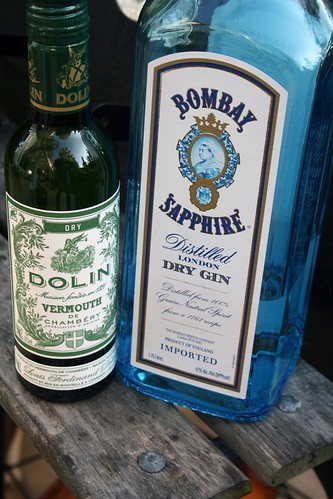
2 ½ oz gin
½ oz dry vermouth
2 olives
ice
Mix. Shake. Pour.
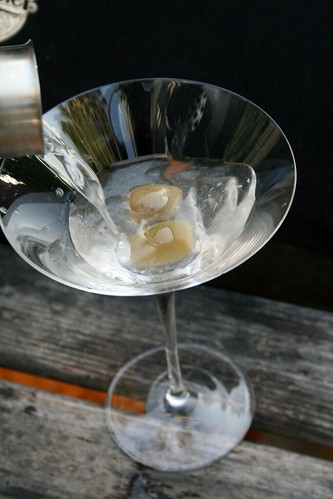
Ahhhhh...
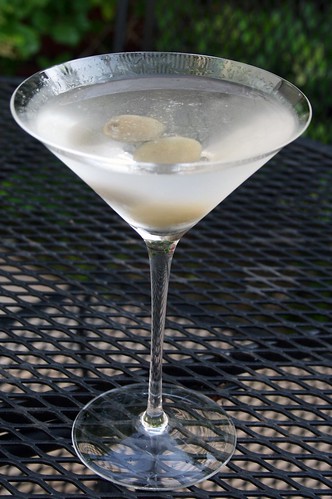

2 ½ oz gin
½ oz dry vermouth
2 olives
ice
Mix. Shake. Pour.

Ahhhhh...

Keywords:
lazy saturday
08 April 2010
Cape Cod clam chowder
I spent the bulk of my first 18 years of life roughly 750 miles from the coast. Most of the sea critters that I ate in that time were of the un-fresh and over-cooked variety. Until I caught my own fish (at around age 14), I was quite certain that fish had to have that awful fishy flavour associated with old fish. (Isn't it interesting that the word "fishy" is associated with old fish? How come the word "beefy" isn't associated with rotten beef?) I knew that I didn't like fish. Turns out I was wrong. I still don't like old, unfresh, overcooked fish.
Well, seafood soups were something I came to late. But holy crap are they all kinds of awesomeness. And until this past weekend, I had never made a clam chowder. I decided to remedy that. I purchased 5 pounds of cherrystone clams from my local Asian grocer, in southern California, to make a modification of this Cape Cod chowder. Yum.
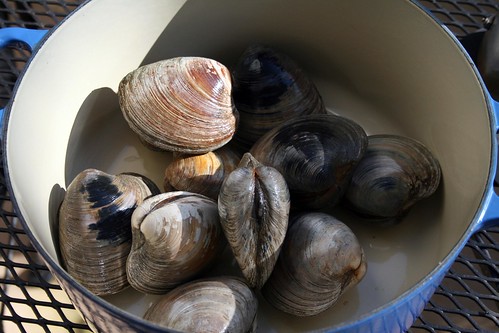
The modifications:
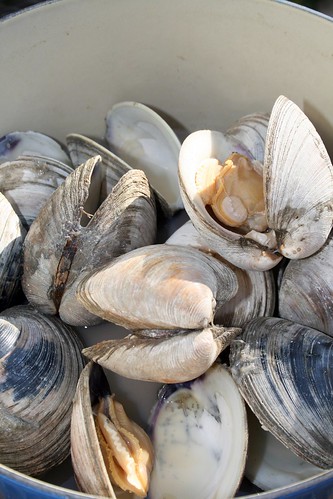
Remove the meat from the clams, and put it in a bowl.

Cover, and put in the fridge to chill. Meanwhile, pour off the broth in the pot, being careful to leave any grit in the pot. You'll want to recover most of the broth (2ish cups).
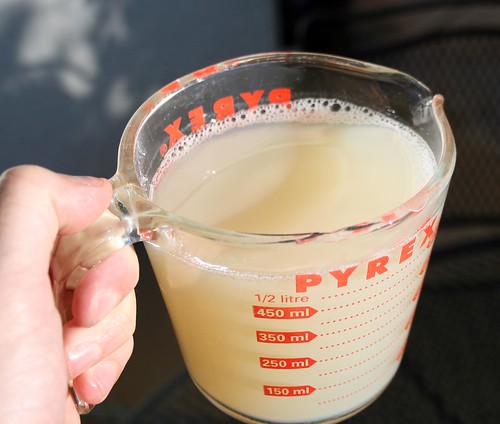
Reserve the broth. Meanwhile, chop up the salt pork (some suggest removing the rind, but why? It's delicious pig skin. Yummy, yummy pig skin). Brown the salt pork over medium heat.
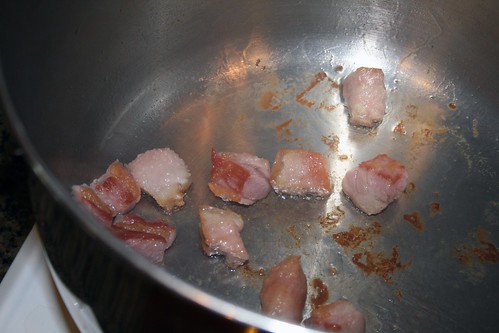
Once browned, add the butter.

Melt the butter. Sauté the onions, garlic, thyme and celery until soft.
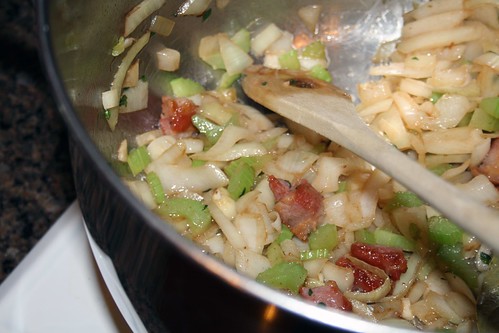
Add the bay leaf, the potatoes and the broth. Bring to a boil, and continue to boil lightly, until the potatoes have softened enough that you can crush them on the side of the pot with a spoon.

While the soup is boiling, chop the clams into nice bite-sized pieces (note the relative term here - Mrs. Dude likes them smaller than me).
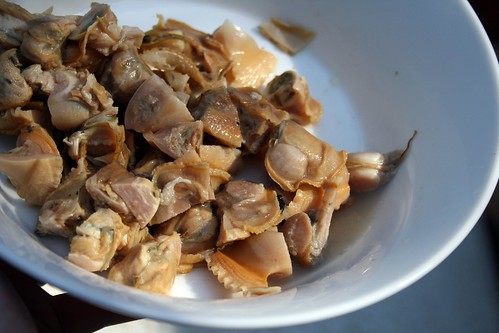
When the potatoes are done, and are smashed to your liking, turn off the heat. Pour in the cream and drop in the clam bits. (You may heat on low at this point, but don't boil - you don't want to cook the clams, just warm them a bit).
Season with pepper (salt wasn't needed - the clams and salt pork bring in a ton), and sprinkle on some parsley.
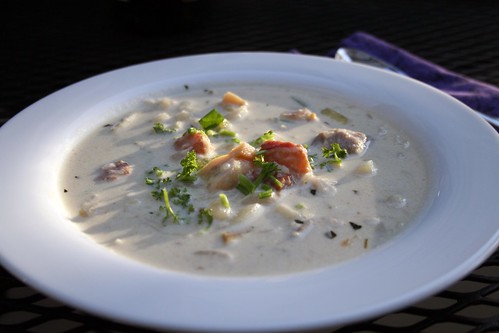
This soup is the best. Rich. Hearty. Salty. And full of crazy good flavour. Love it. Serve with a nice, hearty bread and a slightly sweet white wine.

Well, seafood soups were something I came to late. But holy crap are they all kinds of awesomeness. And until this past weekend, I had never made a clam chowder. I decided to remedy that. I purchased 5 pounds of cherrystone clams from my local Asian grocer, in southern California, to make a modification of this Cape Cod chowder. Yum.

The modifications:
5 pounds cherrystone clamsFirst, clams that are open pre-cooking are dead. Chuck 'em. Rinse the clams. Place in a heavy pot with the water. Cover and bring to a boil. As soon as they start to boil, start a timer for 5 minutes. At the end of 5 minutes, move the clams around a bit, cover the pot and boil for 5 more minutes (you may even want to do this several times over the total 10 minute cooking time, as my clams were a tad unevenly cooked - some were perfect, some were a tad overcooked). Uncover, and remove from heat.
1 cup water
2 ounces meaty salt pork, cut into small (1/3-inch) dice
1 tablespoons unsalted butter
1 medium yellow onions, chopped
2 cloves garlic, finely chopped
1 stalk celery, chopped
5 sprigs fresh thyme, leaves removed and chopped (1 tablespoon)
1 large dried bay leaf
1 pound Yukon gold potatoes, peeled and cut into 1/2- to 3/4-inch dice
1 cup heavy cream
Freshly ground black pepper
salt if needed
1/4 cup chopped fresh parsley

Remove the meat from the clams, and put it in a bowl.

Cover, and put in the fridge to chill. Meanwhile, pour off the broth in the pot, being careful to leave any grit in the pot. You'll want to recover most of the broth (2ish cups).

Reserve the broth. Meanwhile, chop up the salt pork (some suggest removing the rind, but why? It's delicious pig skin. Yummy, yummy pig skin). Brown the salt pork over medium heat.

Once browned, add the butter.

Melt the butter. Sauté the onions, garlic, thyme and celery until soft.

Add the bay leaf, the potatoes and the broth. Bring to a boil, and continue to boil lightly, until the potatoes have softened enough that you can crush them on the side of the pot with a spoon.

While the soup is boiling, chop the clams into nice bite-sized pieces (note the relative term here - Mrs. Dude likes them smaller than me).

When the potatoes are done, and are smashed to your liking, turn off the heat. Pour in the cream and drop in the clam bits. (You may heat on low at this point, but don't boil - you don't want to cook the clams, just warm them a bit).
Season with pepper (salt wasn't needed - the clams and salt pork bring in a ton), and sprinkle on some parsley.

This soup is the best. Rich. Hearty. Salty. And full of crazy good flavour. Love it. Serve with a nice, hearty bread and a slightly sweet white wine.

Keywords:
direct heat,
main course
06 April 2010
Chocolate Easter bunny: or rabbit mole
We have a tradition in our household, going back to my days as an undergrad, that we cook up a rabbit every year at Easter. It's true. We cook the Easter bunny. And every year, he's delicious.
This year, I had grown a tad bored with my standard preparation of rabbit, so I decided to do two traditional cute Easter critters. For main course, we served grilled leg of lamb. That's become a standby recipe here in the Dude household. Well, what about appetizers?
Well what says Easter more than the Easter bunny? I suppose it's a chocolate Easter bunny! So here we go, Rabbit Mole. It's rabbit. It's chocolate. It's spice. Yum.
Modified from the New York Times:
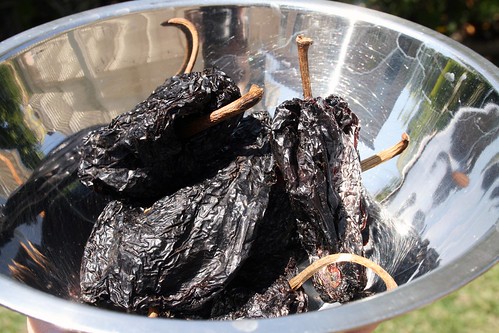
Turn a couple times, to ensure you wet the entire chile. Remove the stems and seeds from the chiles. Save 1 tablespoon of the now brown soaking water. Toss the ancho meat into a blender.
Meanwhile, toast the sesame seeds in a dry pan over medium heat for a few minutes, until they start to turn brown, or until they're nicely fragrant.
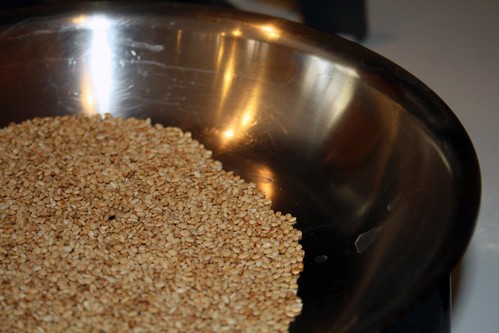
Toss the sesame seeds in the blender with the ancho meat. Add the oregano, tomatoes, cloves, allspice, cinnamon and garlice.

Blend until smooth.
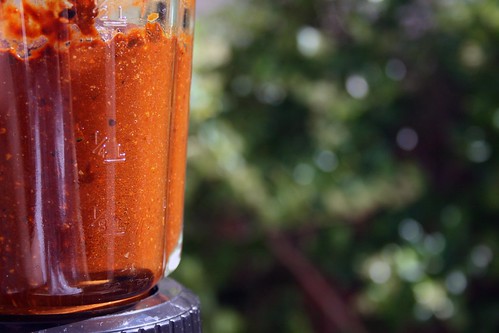
The photo doesn't quite do justice to the colour. It's a darker, chocolate brown colour. Add the banana, bread crumbs and melted chocolate. Blend until smooth. For the rabbit:
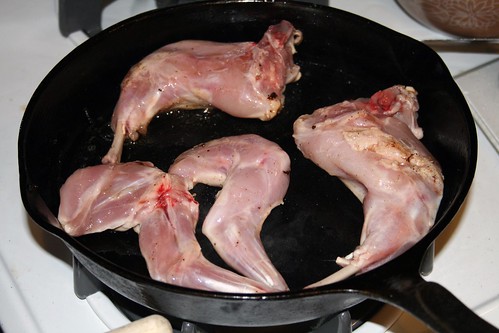
Brown a few minutes on each side until nice and caramelized.
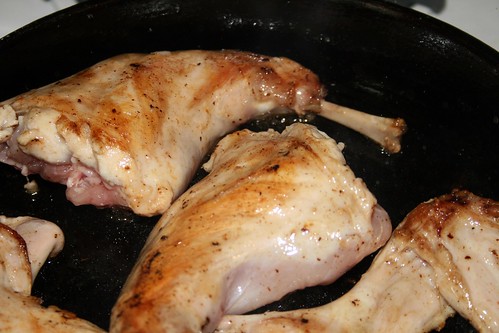
Add onion, garlic, salt, pepper and thyme.
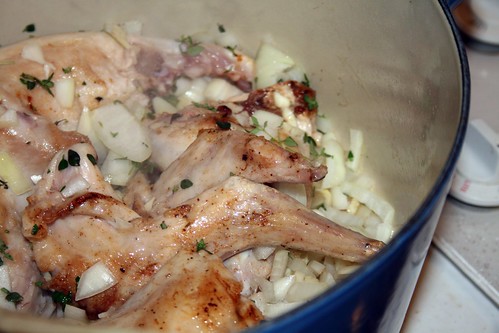
Sauté until the onions are soft.

Add the chicken stock. Simmer on low heat for 30 minutes.
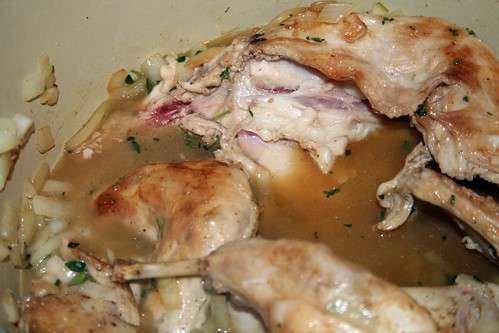
At the end of the 30 minutes, remove the meat from the stock. Pull the meat off of the saddle, so that the difficult to access back and rib meat is pulled free. Coarsely chop the meat. Leave the leg meat on the legs.
Put the mole sauce into the chicken broth/onion/herb mixture. Season (if needed - I added about half a teaspoon of salt).
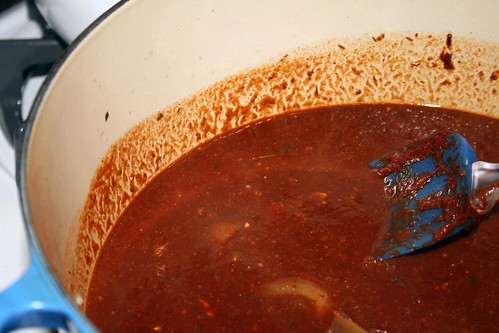
Add back the shredded meat, and the four rabbit legs. Cook for five minutes to warm the meat (you don't want to overcook the rabbit).
Serve with homemade tortillas. (My favourite recipe here).

This was a delicious recipe. Mild in spice. Rich in flavour. Thick and tasty, a nice start to a hearty Easter dinner.
Happy Easter.
This year, I had grown a tad bored with my standard preparation of rabbit, so I decided to do two traditional cute Easter critters. For main course, we served grilled leg of lamb. That's become a standby recipe here in the Dude household. Well, what about appetizers?
Well what says Easter more than the Easter bunny? I suppose it's a chocolate Easter bunny! So here we go, Rabbit Mole. It's rabbit. It's chocolate. It's spice. Yum.
Modified from the New York Times:
8 dried ancho chilesSoak the ancho chiles in the hot boiled water for half an hour (heat off).
2 cups boiling water
1 cup drained, stewed whole tomatoes
¼ cup sesame seeds
1 tablespoon oregano
2 whole cloves
2 whole allspice
¼ teaspoon ground cinnamon
9 cloves garlic, peeled
1/4 cup ripe banana
2 tablespoons dry bread crumbs
¾ ounce bitter chocolate, melted

Turn a couple times, to ensure you wet the entire chile. Remove the stems and seeds from the chiles. Save 1 tablespoon of the now brown soaking water. Toss the ancho meat into a blender.
Meanwhile, toast the sesame seeds in a dry pan over medium heat for a few minutes, until they start to turn brown, or until they're nicely fragrant.

Toss the sesame seeds in the blender with the ancho meat. Add the oregano, tomatoes, cloves, allspice, cinnamon and garlice.

Blend until smooth.

The photo doesn't quite do justice to the colour. It's a darker, chocolate brown colour. Add the banana, bread crumbs and melted chocolate. Blend until smooth. For the rabbit:
1 tablespoon bacon fatFry up some homemade bacon to generate some bacon fat. Add the rabbit to the hot fat.
1 2 1/2-pound rabbit, cut into 5 pieces - 4 legs and the saddle
1 medium onion, minced
4 cloves garlic, minced
1 teaspoon dried thyme
1 teaspoon salt, plus more to taste
1/2 teaspoon black pepper, plus more to taste
2 cups chicken broth

Brown a few minutes on each side until nice and caramelized.

Add onion, garlic, salt, pepper and thyme.

Sauté until the onions are soft.

Add the chicken stock. Simmer on low heat for 30 minutes.

At the end of the 30 minutes, remove the meat from the stock. Pull the meat off of the saddle, so that the difficult to access back and rib meat is pulled free. Coarsely chop the meat. Leave the leg meat on the legs.
Put the mole sauce into the chicken broth/onion/herb mixture. Season (if needed - I added about half a teaspoon of salt).

Add back the shredded meat, and the four rabbit legs. Cook for five minutes to warm the meat (you don't want to overcook the rabbit).
Serve with homemade tortillas. (My favourite recipe here).

This was a delicious recipe. Mild in spice. Rich in flavour. Thick and tasty, a nice start to a hearty Easter dinner.
Happy Easter.
Keywords:
appetizers,
direct heat
01 April 2010
Whole wheat no knead bread
In Canada, we call whole wheat bread "brown bread", as opposed to "white bread". My Dad once visited Detroit, and asked a waitress there to bring him some brown toast for breakfast. At home, that would result in some whole wheat toast. Instead, she brought him very darkly toasted bread.
I've been playing a lot with my new bread book, My Bread by Jim Lahey. This is a fun book. With 2 minutes the night before, and about 10 minutes of work the day you bake it, you can have delicious, crunchy, chewey, tasty bread every day. And this stuff makes wicked toast.
by Jim Lahey. This is a fun book. With 2 minutes the night before, and about 10 minutes of work the day you bake it, you can have delicious, crunchy, chewey, tasty bread every day. And this stuff makes wicked toast.
This past weekend, I made whole wheat no knead bread:
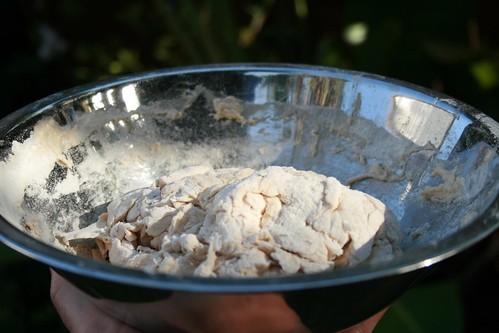
Cover and let rise overnight. (I have let this bread go as little as 16 and as much as 24 hours, and it turns out well).
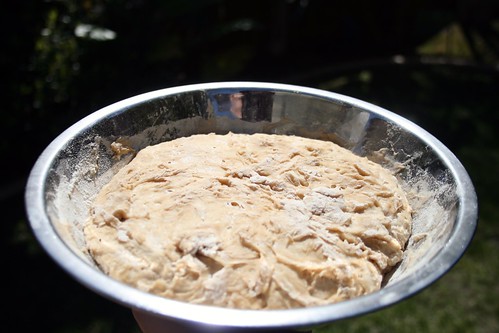
This dough is a little more delicate than a shorter fermented dough. Loosen the dough with a spatula, then fold the edges underneath it into the shape of a loaf.
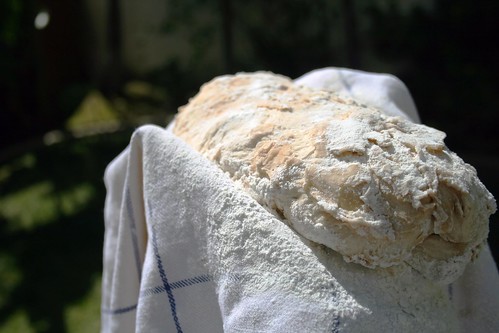
Place it on a well-floured cotton tea towel (not something fuzzy, or terryish - you don't want lint in there). Place it smooth side up (you'll be flipping it into a hot pan later, and want the smooth side on the bottom, ultimately).
Flour, cover, and let rise for 2 hours. Half an hour before the end of rising, heat a Le Creuset (or other enameled, cast-iron casserole pot) closed in an oven at 475°F for 30 minutes.

Remove the pot from the oven. Carefully and gently (and un-hand-burningly), flip the dough into the hot pot.

Cover, and put back in the oven.

Bake in the closed pot for 30 minutes. Uncover.

Bake for another few minutes until browned. I find the non-whole wheat loaves take another 10 minutes to brown. This whole wheat loaf took closer to 20. Remove, and let cool for at least an hour before cutting into it.
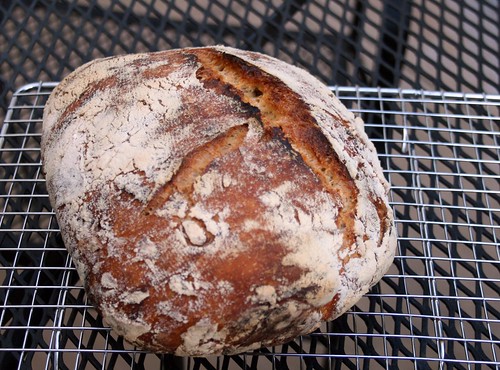
Mrs. Dude loves the crackling the crust makes as it cools. Serve. This bread is a little heavier than the previous one. But it makes fantastic toast, and a great dipping bread for soups. Love it.
This past weekend, I made whole wheat no knead bread:
300 g bread flourThere's a bit more yeast in this than in the regular no knead bread. The night before baking, mix together all the ingredients just until wet.
100 g whole wheat flour
8 g salt
½ tsp active dry yeast
300 g water
additional flour for dusting

Cover and let rise overnight. (I have let this bread go as little as 16 and as much as 24 hours, and it turns out well).

This dough is a little more delicate than a shorter fermented dough. Loosen the dough with a spatula, then fold the edges underneath it into the shape of a loaf.

Place it on a well-floured cotton tea towel (not something fuzzy, or terryish - you don't want lint in there). Place it smooth side up (you'll be flipping it into a hot pan later, and want the smooth side on the bottom, ultimately).
Flour, cover, and let rise for 2 hours. Half an hour before the end of rising, heat a Le Creuset (or other enameled, cast-iron casserole pot) closed in an oven at 475°F for 30 minutes.

Remove the pot from the oven. Carefully and gently (and un-hand-burningly), flip the dough into the hot pot.

Cover, and put back in the oven.

Bake in the closed pot for 30 minutes. Uncover.

Bake for another few minutes until browned. I find the non-whole wheat loaves take another 10 minutes to brown. This whole wheat loaf took closer to 20. Remove, and let cool for at least an hour before cutting into it.

Mrs. Dude loves the crackling the crust makes as it cools. Serve. This bread is a little heavier than the previous one. But it makes fantastic toast, and a great dipping bread for soups. Love it.
Keywords:
bread,
indirect heat
Subscribe to:
Posts (Atom)
